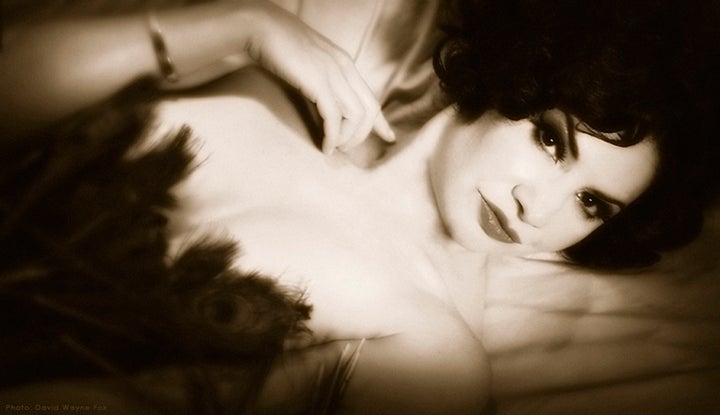ALLA NAZIMOVA, is quite possibly the most famous star you’ve never heard of, until now. Places, a tour-de-force multimedia solo performance written and performed by Romy Nordlinger, tells the story of Alla Nazimova, the rule-breaking Broadway and Hollywood legend. From a Jewish immigrant fleeing Tsarist Russia to Hollywood’s first female director and producer, Nazimova was a trailblazer who wouldn’t be silenced. Nordlinger’s solo performance reimagines one of the most daring and censored artists of the 20th century who tells it like it was… and still is.
Romy, when did you discover Alla's story and start working on Places?
ROMY NORDLINGER: I was approached by Mari Lyn Henry, theatre historian, fellow League of Professional Theatre Member and the founder of The Society For The Preservation Of Theatrical History. She was developing an amazing piece of theatre called Stage Struck based on the lives of what might otherwise remain unknown legendary women in theatre. She introduced me to Alla Nazimova and I was absolutely smitten! I began developing and performing the piece about Nazimova which started as a 15 minute monologue, then met Katie McHugh who was to become the director of the full production of PLACES. Katie suggested that I turn Nazimova’s story into a full length play. I was absolutely awestruck by Nazimova. She was at one time the highest paid actress in Hollywood’s silent movies and had a Broadway theatre named after her. She was also the first female writer, director and producer in Hollywood and a trailblazer who was was incredibly outspoken and openly bisexual in a time where no one was ‘out’. Where did her story go? Why was she virtually erased from the history books and how could we forget such a giant? In writing my solo show about Nazimova, I was determined to set the record straight and to tell her magnificent story. We are all the stories we tell, and an artist is only dead when the last person to remember them dies.
Can you tell me about the research you did in creating Places? In a period piece like this I imagine that there are many details our readers would love to know about!
ROMY NORDLINGER: I read everything about Nazimova that I possibly could, including biographies and her journals. I also read what other artists had said about her. She was the inspiration for so many of our greats: Ibsen, Strindberg, Chekhov, O’ Neill, Tennessee Williams and countless others. She was the first superstar that came from Russia’s Moscow Art Theater, a progenitor of Stanislavsky. I researched the Moscow Art Theater and Russia from roughly 1890 to 1910 when she had lived there.
I looked at countless pictures of her. She was a chameleon, the Madonna of her time, and changed her looks constantly. As she said “I am neither tall nor short, fat or thin, ugly or beautiful, I am what the part demands of me.” She was very flamboyant when the part called for her to be, and designed all her own costumes even while on Broadway in “A Doll’s House” and “Hedda Gabler” – where she also directed herself in her productions. In Places I portray her in only one of her many looks, so the emphasis is on her rather than her costumes, yet I do add elements of her larger than life character: her flamboyant makeup and robe along with hair that is piled very high on her head, the way she wore it in her infamous portrayal of “Camille”, a film which she also directed.
I watched as many of her films that I could get ahold of, surprisingly many are on YouTube, but many more ended up locked away in a vault somewhere collecting dust. With her visionary piece Salome, she introduced a new era: The birth of the art film. That same film also brought about her demise for its forward thinking homosexual cast, and Art Deco, abstract modernity.
My research also included reading about her mansion, her “Garden Of Allah” (dubbed the Camelot of Hollywood) which became the watering hole for great luminaries of literature and the performing arts, such as F. Scott Fitzgerald and Greta Garbo, and a haven for intellectual liberty and freedom. It also was the setting where the term the ‘Sewing Circle’ was born; an acronym for her all women’s lesbian gatherings.
In the end, her story is an amalgam of herself and myself. As she was not here to interview, her story is told through the lens of my perspective.

Nordlinger as Nazimova
Who are some women in film today that you find inspiring?
ROMY NORDLINGER: Some of my favorite actresses are Judi Dench, Vanessa Redgrave, Meryl Streep, Jessica Lange, and Marion Cotillard. They all are able to transform themselves and really get under the skin of a character. There is a charge to those actresses, a daring and, particularly with Jessica Lange, a ferocious vulnerability that is fearless and heartbreaking. There’s a British television series called “Happy Valley” and the lead actresses, Sarah Lancashire & Siohban Finneran are absolutely riveting! It was created, directed and produced by the equally brilliant Sally Wainwright. The whole series is amazing. I particularly admire how the women are allowed to be real. No veneers on their teeth or botox or overly airbrushed and starvation sized physiques. They are beautiful and themselves.
Tell us about the process for creating the films?
ROMY NORDLINGER: I wanted the images to not only be a backdrop, but to be an organic part of Nazimova’s thoughts which are also projected upon her, become a part of her. The brilliant video is created by Adam Burns and equally brilliant original score sound design is by Nick T. Moore. Nazimova’s thoughts are brought to life on the screen in a non-stop flow of video, images, and sound, a postmodern cacophony from her all seeing perspective. Adam and Nick have researched amazing amounts of video and sound throughout time of jugular soundbites and video on women’s rights and gay rights from history to create a collage. After effects layers (smoke, dappling light, etc.) unite the flow of her stream of consciousness in video. Some of the images are of Nazimova and some of them are of me portraying Nazimova. Nick’s beautifully atmospheric and touching compositions are a part of an evocative soundscape designed to immerse the audience in Nazimova’s world. Adam’s voluptuous video designs are a palette of black and white projections where he has created a film texture and tone that matches the grainy quality of silent era 16 millimeter films.
I wanted the audience to see this not as a ‘museum’ piece but a piece that was very relevant today. Nazimova was fighting the things in the 19th century and early 20th century that we are still fighting today, but alone and without a twitter account: sexism, racism, homophobia, ageism. I juxtapose her life through the lens of her being an all seeing ghost who is able to peer into the life of the 21st century and reflect on the past and present simultaneously. As Nazimova says, “By opening our eyes to the past, we are better able to see our present.” I also wanted to include the cinematic look of her life with the multimedia elements of the play. As she was a film star and director and so much of her life was on screen, it was vital to use the same mediums to tell her story – the story and visions that were brushed under the rug because they were so ahead of her time.
What is it like prepping to attend Edinburgh?
ROMY NORDLINGER: We are prepping to put this show on at East To Edinburgh here in NYC at 59E59 prior to our month long run in Edinburgh. The director and creative team are facing great challenges working on preparing for two festivals where the technical specifications are different for both and the time to set up for both is incredibly quick (as is in a festival setting). The designers and directors are working with the technical director of the theatre in which we’ll be performing in Edinburgh so that we can be ready as soon as we get off the plane from performing in New York. There’s also the challenge of how to bring our screen rigging with us and keep it portable and light and adaptable to both theatres.
As an actress, I am mentally trying to prepare to be ready to perform in both spaces with very little time rehearsing in either or with the video and sound elements to accompany. This involves my being as comfortable with the script and character as I can possibly be. I’m also trying to mentally prepare for doing a solo show for 26 consecutive performances with only one day between performing here for six performances in NYC.
I am reading all I can about the Edinburgh Fringe and know it will be both exciting and overwhelming! There are over 3000 shows taking place simultaneously and it is the 70th anniversary of the Edinburgh Fringe so it’s even more exciting. We are fortunately working with an amazing production team in Edinburgh called Civil Disobedience Productions. They are instrumental in helping us to have a strong presence there as well as the nuts and bolts of surviving and succeeding in the Fringe. I feel challenged and jazzed. When I’m feeling most challenged I remind myself that Nazimova was always overcoming obstacles and believed that there was nothing really worthwhile in life that wasn’t without a fight. I also try to remind myself that I am going to tell her story, it’s not about me, and that imbues me with courage.
Any advice for little girls? Young women just starting out in the theater?
ROMY NORDLINGER: There will be times when you feel that it all makes sense and you wouldn’t choose to do anything else, and then other times when you wonder why in creation you chose a life in the performing arts. Whatever you choose to do in life there will always be highs and lows. We all grow as we grow. I’d say most of all, try very hard not to compare your path to that of others. Comparison paves the way for constant self criticism and not staying in the moment. Define success for yourself, not another person’s definition of what success is, what it looks like. Try to remember that you are the only person who will ever be able to portray a character or tell a story in your own unique way, that you have something very special to offer. Watch people, read books, go to museums, be interested in the human condition and love the art in yourself, not yourself in the art.
Places will run in New York at 59E59 Theaters (59 East 59th Street, between Park and Madison Avenues) on Friday, July21st through Sunday, July 30th. Tickets: http://bit.ly/2t4kkDa or placestheplay.com
Places will run in Scotland at Edinburgh Fringe Festival at the New Town Theatre (Venue 7). The performance dates are August 3rd -14th and 16th -27th at 5 pm. Tickets: EdFringe.com
Places is presented by Yonder Window Theatre Company, Parity Productions and Civil Disobedience Productions

